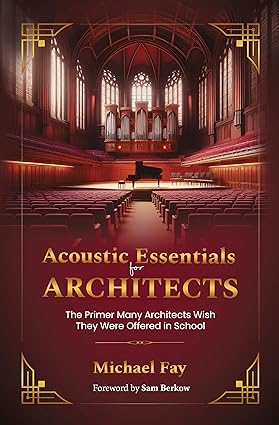
Acoustic Essentials for Architects by Michael Fay is a practical primer to help architects understand the relationship between shapes, textures, dimensions, and sound in architectural design. It explains terminology, feasibility aspects, acoustic trade-offs, and practical tips for improving speech intelligibility and acoustical planning in medium to large spaces.
| Field | Information |
|---|---|
| Title | Acoustic Essentials for Architects: The Primer Many Architects Wish They Were Offered in School |
| Author | Michael Fay |
| Publisher | J. Ross Publishing |
| Publication Date | May 27, 2025 |
| Language | English |
| Format | Kindle eBook |
| ASIN | B0F63YNVM9 |
| ISBN-13 | 978-1604278668 |
| Print Length | 267 pages |
| File Size | 6.3 MB |
| Accessibility | Screen Reader: Supported, Word Wise: Enabled, Enhanced Typesetting: Enabled, Page Flip: Enabled, X-Ray: Not Enabled |
| Genre | Architecture, Acoustics, Design Guide |

Acoustics is architecture’s invisible dimension—felt, but rarely seen. In Acoustic Essentials for Architects: The Primer Many Architects Wish They Were Offered in School, the author bridges a long-standing educational gap by offering architects, designers, and students a practical and highly approachable guide to understanding sound within the built environment.
Read More: 10 Rom-Com Books Better Than Netflix
Written in a conversational, low-tech style by a veteran with over four decades of hands-on experience, this book demystifies acoustics without overwhelming readers with intimidating jargon. Rather than reducing acoustics to formulas and technical abstractions, the author emphasizes visualization—helping architects grasp how shapes, textures, and dimensions interact with sound in tangible, real-world ways.
The book covers a wide spectrum of essential concepts: from the dimensional vastness of sound wavelengths to the subtle trade-offs that arise when blending design aesthetics with acoustical functionality. Particularly noteworthy is the discussion on speech intelligibility and seating symmetry in medium and large rooms, a critical but often overlooked factor in educational spaces, auditoriums, and places of worship. By highlighting these practical considerations, the text empowers architects to shift from accidental acoustics to deliberate, outcome-driven designs.
What sets this book apart is its clarity and accessibility. While many texts on acoustics cater primarily to engineers, Acoustic Essentials for Architects speaks directly to the design community, filling a void left by architectural curricula that too often treat acoustics as an afterthought. The peer-reviewed structure lends credibility, but the approachable tone ensures it remains engaging and digestible.
For practicing architects, this book offers a valuable refresher that can immediately influence project outcomes. For students, it acts as the missing primer that could reshape how they consider acoustics from the earliest design stages. And for anyone passionate about the intersection of form, function, and sensory experience, it highlights why sound is just as fundamental as light and space in shaping human experience.
Verdict
Acoustic Essentials for Architects is both practical and philosophical—a guide that not only explains “how” but also “why” acoustics matter in design. It transforms sound from a peripheral consideration into a central design tool, empowering architects to create spaces that are not only visually stunning but also acoustically intentional.






